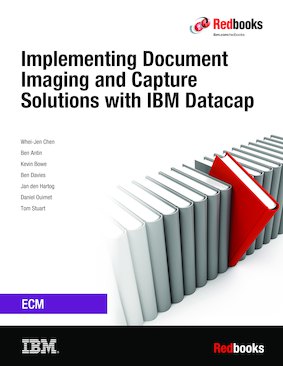About cookies on this site Our websites require some cookies to function properly (required). In addition, other cookies may be used with your consent to analyze site usage, improve the user experience and for advertising. For more information, please review your options. By visiting our website, you agree to our processing of information as described in IBM’sprivacy statement. To provide a smooth navigation, your cookie preferences will be shared across the IBM web domains listed here.

Published on 03 October 2015, updated 27 October 2015
Read in Google Books Order hardcopy
Share this page:
ISBN-10: 0738440906
ISBN-13: 9780738440903
IBM Form #: SG24-7969-01
Authors: Whei-Jen Chen, Ben Antin, Kevin Bowe, Ben Davies, Jan den Hartog, Daniel Ouimet and Tom Stuart
Abstract
Organizations face many challenges in managing ever-increasing documents that they need to conduct their businesses. IBM® content management and imaging solutions can capture, store, manage, integrate, and deliver various forms of content throughout an enterprise. These tools can help reduce costs associated with content management and help organizations deliver improved customer service. The advanced document capture capabilities are provided through IBM Datacap software.
This IBM Redbooks® publication focuses on Datacap components, system architecture, functions, and capabilities. It explains how Datacap works, how to design a document image capture solution, and how to implement the solution using Datacap Developer Tools, such as Datacap FastDoc (Admin). FastDoc is the development tool that designers use to create rules and rule sets, configure a document hierarchy and task profiles, and set up a verification panel for image verification.
A loan application example explains the advanced technologies of IBM Datacap Version 9. This scenario shows how to develop a versatile capture solution that is able to handle both structured and unstructured documents. Information about high availability, scalability, performance, backup and recovery options, preferable practices, and suggestions for designing and implementing an imaging solution is also included.
This book is intended for IT architects and professionals who are responsible for creating, improving, designing, and implementing document imaging solutions for their organizations.
Table of Contents
Chapter 1. Advanced imaging
Chapter 2. Advanced Datacap capabilities
Chapter 3. Advanced imaging architecture overview
Chapter 4. Planning considerations
Chapter 5. Designing a Datacap solution
Chapter 6. Structured forms application
Chapter 7. Unstructured document application
Chapter 8. System scalability, availability, backup, and recovery
Chapter 9. Export and integration
Chapter 10. Datacap user experience in IBM Content Navigator
Chapter 11. Datacap Mobile user experience
Chapter 12. Customizing Datacap
Chapter 13. Datacap scripting
Chapter 14. Classification and separation